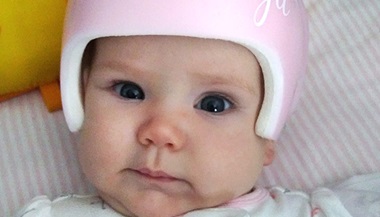Craniofacial Abnormalities
What You Need to Know
- Babies’ skulls consist of plates of bone separated by soft areas called sutures. These sutures eventually fuse, but should remain open early in infancy to allow for the brain and skull to grow.
- Craniofacial malformations, including craniosynostosis, are the result of an infant’s skull or facial bones fusing together too soon or in an abnormal way.
- When the bones fuse together too early, the restricted growth of the skull may increase pressure on the brain, which can cause neurological problems.
- Surgery may be necessary to correct the shape of the face and skull and provide room for the baby’s growing brain.
Symptoms of Craniofacial Abnormalities
Craniofacial malformations can be mild or severe, and depend on which parts of the infant’s skull are affected. Certain syndromes result in telltale facial anomalies:
Apert syndrome: A craniofacial abnormality characterized by an abnormal head shape, small upper jaw, and fusion of the fingers and toes.
Brachycephaly: A birth defect characterized by the disproportionate shortness of the head. It is caused by a premature fusing of the coronal suture near the front of the skull. Brachycephaly is commonly associated with a number of syndromes, including Apert, Crouzon, Pfeiffer, Saethre-Chotzen and Carpenter.
Crouzon syndrome: A birth defect characterized by abnormalities in the skull and facial bones caused by a fusing of both sides of the coronal suture. This syndrome often causes the skull to be short in the front and back. Flat cheek bones and a flat nose are also typical of this disorder.
Encephalocele: A condition characterized by a protrusion of the brain or its coverings through the skull.
Kleeblattschadel syndrome: A very rare birth defect characterized by abnormalities of the skull and facial bones. It is caused by a premature fusing of almost all of the fibrous sutures. It is also called cloverleaf skull.
Oxycephaly: A birth defect characterized by abnormalities in the skull and facial bones. This syndrome causes the top of the skull to be pointed or cone-shaped. It is caused by a premature fusing of the coronal suture and the sagittal suture, which runs front to back, down the middle of the top of the head. It is also known as turricephaly or high-head syndrome.
Pfeiffer syndrome: A birth defect characterized by abnormalities of the skull, hands and feet. This syndrome results in wide-set, bulging eyes; an underdeveloped upper jaw; and a beaked nose due to the head being unable to grow normally.
Saethre-Chotzen syndrome: A birth defect characterized by an unusually short or broad head. In addition, the eyes may be spaced wide apart, eyelids may be droopy, and fingers may be abnormally short and webbed.
Scaphocephaly: A long, narrow head shape resulting from early fusion of the sagittal suture.
Trigonocephaly: A triangular configuration of the skull caused by the premature fusion of the two halves of the frontal bones at the metopic suture, which extends down the middle of the forehead toward the nose.
Facebook Live: July is National Cleft and Craniofacial Awareness Month”
Diagnosis of Craniofacial Abnormalities
Some of these syndromes are apparent at birth, while others are not obvious until a baby’s head grows larger over the first few months of life. Most of the time, your physician can identify a craniofacial abnormality by examination alone. Examining your child’s skull, brain and facial structure with an MRI or CT scan can help clarify the diagnosis.
Babies’ heads grow rapidly the first year of life, which is why these conditions are likely to be diagnosed and require treatment in early infancy. Your pediatrician may recommend observation for a few weeks or months to see if your child’s condition is going to progress. You may be referred to a plastic surgeon or neurosurgeon, who can work with you to develop the most appropriate treatment plan for your child.
Treatment for Craniofacial Abnormalities
Craniofacial Surgery
For craniosynostosis, your doctor will likely recommend surgery to correct the shape of the skull and facial bones and allow for the brain to appropriately develop.
These surgeries can be complex and intensive, requiring removal, reshaping and replacing parts of the skull. In some cases, minimally invasive treatments are possible. Pediatric neurosurgeons often work with pediatric craniofacial plastic surgeons to ensure the best result.
Skull reconstruction may involve surgeons using sutures, wires, or small screws or plates to stabilize the bone and protect the brain as your child grows. These materials are often too small to be felt under the skin and, in some cases, are absorbed by the body over time.
Minimally Invasive Surgery
In some cases, if your child’s anomaly is diagnosed before he or she is 3 months old, the surgical team may be able to use one of several minimally invasive procedures. These endoscopic approaches can lessen complications and the risk of needing blood transfusions compared with open surgery, and can also mean faster recovery for your child.
Minimally invasive operations may be followed with helmet therapy, in which your child wears a special helmet to gently guide the growing skull bones into position so they can fuse in a more typical manner.
When should a specialist be consulted?
Consult a specialist as soon as possible. Prompt evaluation with a specialist is essential to ensure that the child has the full range of therapies available and the best overall outcome.







